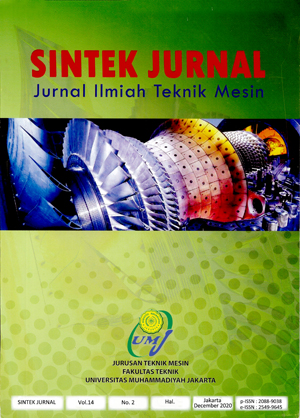EFFECT OF CYLINDER SURFACE ROUGHNESS TO THE DISTANCE FORMATION OF VORTEX
Main Article Content
Abstract
Article Details
- Articles published in SINTEK JURNAL are licensed under a Creative Commons Attribution-ShareAlike 4.0 International license. You are free to copy, transform, or redistribute articles for any lawful purpose in any medium, provided you give appropriate credit to the original author(s) and SINTEK JURNAL, link to the license, indicate if changes were made, and redistribute any derivative work under the same license.
- Copyright on articles is retained by the respective author(s), without restrictions. A non-exclusive license is granted to SINTEK JURNAL to publish the article and identify itself as its original publisher, along with the commercial right to include the article in a hardcopy issue for sale to libraries and individuals.
- By publishing in SINTEK JURNAL, authors grant any third party the right to use their article to the extent provided by the Creative Commons Attribution-ShareAlike 4.0 International license.
References
B. Zhou, X. Wang, W. M. Gho, and S. K. Tan, “Force and flow characteristics of a circular cylinder with uniform surface roughness at subcritical Reynolds numbers,” Appl. Ocean Res., vol. 49, pp. 20–26, 2015, doi: 10.1016/j.apor.2014.06.002.
C. H. K. Williamson and R. Govardhan, “Vortex-induced vibrations,” Annu. Rev. Fluid Mech., 2004, doi: 10.1146/annurev.fluid.36.050802.122128.
B. M. Sumer and J. Fredsøe, Hydrodynamics around cylindrical strucures, vol. 26. 2006.
Y. Gao, L. Liu, L. Zou, Z. Zhang, and B. Yang, “Effect of surface roughness on vortex-induced vibrations of a freely vibrating cylinder near a stationary plane wall,” Ocean Eng., 2020, doi: 10.1016/j.oceaneng.2019.106837.
T. Zhou, S. F. M. Razali, Z. Hao, and L. Cheng, “On the study of vortex-induced vibration of a cylinder with helical strakes,” J. Fluids Struct., vol. 27, no. 7, pp. 903–917, 2011, doi: 10.1016/j.jfluidstructs.2011.04.014.
M. Street and G. Glasgow, “Drag Reduction of Deepwater Risers by the Use of Helical Grooves,” pp. 1–5, 2017.
L. Wang, M. B. Cardenas, D. T. Slottke, R. A. Ketcham, and J. M. Sharp, “Modification of the Local Cubic Law of fracture flow for weak inertia, tortuosity, and roughness,” Water Resour. Res., 2015, doi: 10.1002/2014WR015815.
M.MaceasbA.F.OsoriobF.Bolanosa, “A methodology for improving both performance and measurement errors in PIV,” Flow Meas. Instrum., 2020.
J. Westerweel, G. E. Elsinga, and R. J. Adrian, “Particle image velocimetry for complex and turbulent flows,” Annual Review of Fluid Mechanics. 2013, doi: 10.1146/annurev-fluid-120710-101204.
I. T. Dwita, “Aplikasi Gelembung Hidrogen untuk Analisa Dinamika Fluida pada Bola, Bola Golf dan Orifis di Aliran Fluida.”
D. R. Sabatino, T. J. Praisner, C. R. Smith, and C. V. Seal, “Hydrogen Bubble Visualization,” in Flow Visualization, Imperial College Press, 2012, pp. 27–45.
M. Bazargan, D. Fraser, and V. Chatoorgan, “Effect of buoyancy on heat transfer in supercritical water flow in a horizontal round tube,” J. Heat Transfer, vol. 127, no. 8, pp. 897–902, 2005, doi: 10.1115/1.1929787.
Y. Liu, J. Li, and A. J. Smits, “Roughness effects in laminar channel flow,” J. Fluid Mech., vol. 876, pp. 1129–1145, 2019, doi: 10.1017/jfm.2019.603.
K. Luo, H. Zhang, M. Luo, X. Wu, and J. Fan, “Effects of solid particles and wall roughness on turbulent boundary layer in a two-phase horizontal channel flow,” Powder Technol., vol. 353, pp. 48–56, 2019, doi: 10.1016/j.powtec.2019.05.009.


